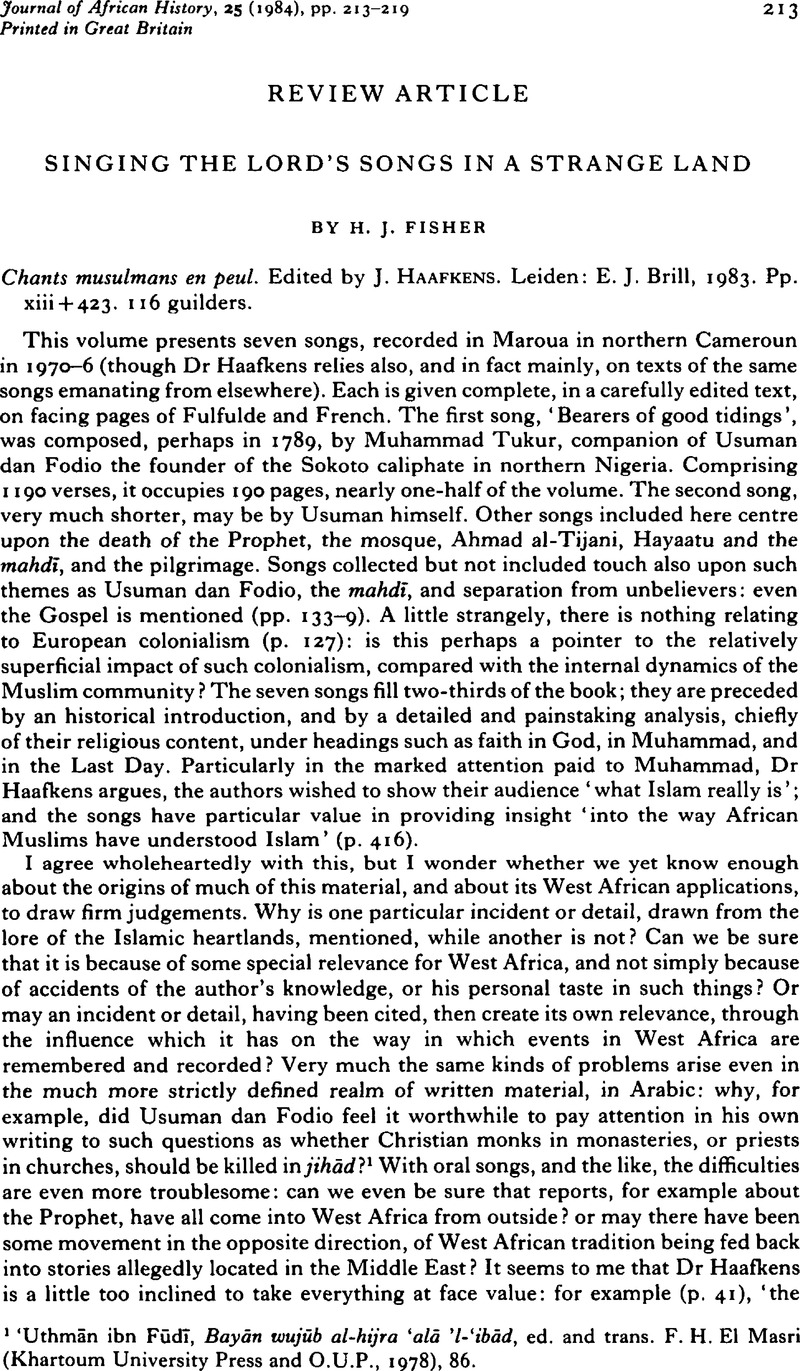No CrossRef data available.
Article contents
Singing the Lord's Songs in a Strange Land
Published online by Cambridge University Press: 22 January 2009
Abstract

- Type
- Review Article
- Information
- Copyright
- Copyright © Cambridge University Press 1984
References
1 ‘Uthrnān ibn Fūdī, Bayān wujūb al-hijra ‘alā’ l-'ibād, ed. and trans. El Masri, F. H. (Khartoum University Press and O.U.P., 1978), 86.Google Scholar
2 A stimulating and imaginative paper, ‘The role of women as “agents religieux” in Sokoto’, by Jean Boyd of the Sokoto State History Bureau and Murray Last of University College, London, was presented in December 1982 to a conference at the Maison des Sciences de l'Homme in Paris, and provides a number of interesting parallels and comparisons with Dr Haafkens’ material.
3 The relatively free participation of women in Islamic festivals may be documented for many parts of black Africa, at many different times: T. E. Bowdich, for example, a contemporary of Usuman dan Fodio, noticed it in Kumasi, the capital of Ashanti in modern-day Ghana, , in 1816, (Mission from Cape Coast to Ashantee, London, 1819, 129).Google Scholar
4 Gray, R., ‘Christianity and religious change in Africa’, African Affairs, LXXVII, 306 (January 1978), 96–98.Google Scholar
5 Dr Murray Last, to whom I am indebted for various improvements in this review article, suggests that there may be another possible explanation: that Muhammad Tukur was himself a somewhat lukewarm supporter of the jihad, and may here be defending his own lukewarmness. See, for example, Last, M., ‘Second interim report on the recovery of the Arabic script literature of the north: additions to the collection of manuscripts on microfilm at Zaria 1966–1967’, in the Second interim report of the Northern History Research Scheme (Zaria, 1967), 39.Google Scholar
6 The terminology for slaves, and for people in other degrees of subordinate status, is complex; see, for example, Burnham, P., ‘Racial classification and identity in the Meiganga region: north Cameroon’, in Baxter, P. and Sansom, B. (eds.), Race and Social Difference (Penguin, 1972), especially 309–313.Google Scholar
7 For example, oral tradition attributes to the first askiya of Songhay charms enabling him to create a forest, a river, and a mountain; Rouch, J., ‘Contribution à l'histoire des songhay’, Memoires de l'Institut français d'Afrique noire, no. 29 (II) (IFAN-Dakar, 1953), 196–197.Google Scholar
8 Hiskett, M., ‘The “Song of the Shaihu's miracles”: a Hausa hagiography from Sokoto’, African Language Studies, XII (1971), 75, 77Google Scholar; see also Tremearne, A. J. N., Hausa Superstitions and Customs: An Introduction to the Folk-lore and the Folk (London, 1913), 160.Google Scholar
9 Rouch, , Contribution, 187.Google Scholar
10 Hiskett, , ‘Song’, 95Google Scholar; there is also another, rather different, pit (in this case in fact a well) miracle on page 85.


